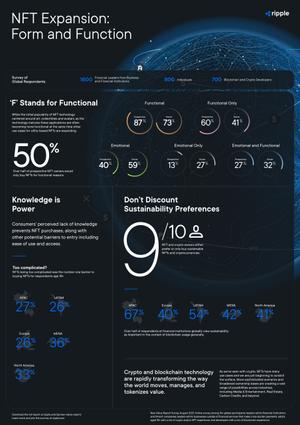A new infographic breaking down attitudes towards non-fungible tokens (NFTs) shows that over half of prospective owners would only purchase an NFT for functional reasons.
In addition, upon surveying hundreds of individuals from around the globe, a remarkable 90% said they prefer to purchase or have only purchased sustainable NFTs and cryptocurrencies. Survey participants further highlighted ease of use and access as key blockers to more NFT purchases—specifically highlighting complexity as the number one barrier.
These considerations are paramount for creators and marketplaces alike as multiple industries continue to evaluate the role and opportunity for NFTs.
Power and Potential of NFTs
NFTs operate as a link between the real and virtual worlds. Digital art and collectibles helped prove one early use case of these tokens, but they also have a functional ability to solve real-world challenges like distribution and compensation.
For example, recording ownership of a given asset as an NFT could supercharge film productions, music royalties or season ticket programs for sports franchises. Tokenizing these real-world items could lead to better rights management, consumer engagement and accessibility for more people—unlocking entirely new business models in the process.
Ripple continues to invest in other high-priority NFT use cases such as carbon markets. By tokenizing carbon credits as NFTs, for example, NGOs and suppliers alike can gain transparency and integrity from improved verification and certification capabilities.

Advantages Inherent in XRPL
As more industries deploy NFTs as part of a broader shift to tokenization, there is a growing demand for a blockchain tailored to the unique needs of owners, creators and the environment. A fast, low-cost and scalable chain, the carbon-neutral XRP Ledger (XRPL) is ideally suited for creating and distributing NFTs.
If adopted by the XRPL community, XLS-20—Ripple’s proposed NFT protocol—would allow NFT transactions to close on XRPL in less than five seconds and cost only a fraction of a penny to mint, buy and sell them. The XRP Ledger is also able to handle high transaction volumes, making it perfect for rapidly scaling enterprise NFT applications, in-game NFTs and more.
What’s more, the launch of an NFT-Devnet earlier this year to experiment with a newly proposed standard for native, on-ledger NFTs makes XRPL development and usage easier and more widely accessible for developers.
The Tokenized Future Ahead
Similar to the adoption curve of crypto, it’s still early days for NFTs, but interest in this technology is growing as more art and collectibles are made and expanded use cases across entertainment, business and sustainability are developed.
As a greater number of these powerful utility-based NFTs take root, they will become important contributors to our vision for an Internet of Value
To learn more about NFT support on the XRP Ledger, visit XRPL.org.









